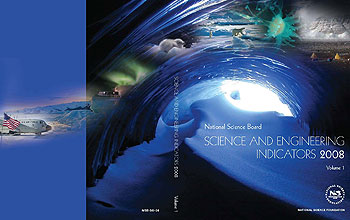Media Advisory 08-001
National Science Board to Release and Discuss Science and Engineering Indicators 2008
Jan. 15, 2008, 10 a.m. on Capitol Hill; 2 p.m. at the U.S. Chamber of Commerce

The Science and Engineering Indicators 2008 cover celebrates the 2007-2009 International Polar Year
January 14, 2008
This material is available primarily for archival purposes. Telephone numbers or other contact information may be out of date; please see current contact information at media contacts.
Members of the National Science Board will rollout Science and Engineering Indicators 2008, the Board's biennial report on the state of science and engineering research and education in the United States, first at 10 a.m. on Jan. 15, in the House Science and Technology Committee Hearing Room. At 2 p.m. Board members will participate in a program focused on the Indicators' picture of Industry at the U.S. Chamber of Commerce.
Every two years, the Board presents its report to the president and Congress. Called the "gold standard," it is the most comprehensive source of information on research and development conducted by universities, industry, the federal government and the international science and engineering enterprise. This will be the earliest release date for any issue of the Science and Engineering Indicators (SEI) series.
Both presentations will focus on data in Indicators 2008 and the Board's conclusions contained in its companion piece, Research and Development: Essential Foundation for U.S. Competitiveness in a Global Economy. The companion piece focuses on the important role of research and development and basic research supported by industry and the federal government in sustaining U. S. global competitiveness in high technology industries. The Board will also introduce its new publication, Digest of Key Science and Engineering Indicators 2008, containing a selected set of important indicators to be electronically linked with detailed data tables and discussions in the main volumes of SEI.
Reporters unable to attend in person may visit http://www.nsf.gov/statistics/indicators to access a PDF version of Science and Engineering 2008 after 10 a.m. on Jan. 15, and/or contact Lisa-Joy Zgorski at the National Science Foundation (NSF) to schedule interviews with presenters, Board members, and other NSF officials. Embargoed copies of the Digest are available on request.
WHAT: | Rollout, Science and Engineering Indicators 2008
|
WHEN: WHERE: | Jan. 15, 2008, 10 a.m. House Science and Technology Committee Hearing Room, 2318 Rayburn House Office Building
|
WHO: | Steven Beering, Chairman, National Science Board |
The confluence of a range of indicators raises important questions about future U.S. high technology industry's competitiveness in international markets and implications for highly skilled jobs at home. The importance of understanding the implications of these indicators underscores the need for new metrics to guide federal government investment strategies for research and development in these key areas.
WHAT: | ROLLOUT, SCIENCE AND ENGINEERING INDICATORS 2008 AND THE STATE OF INDUSTRY IN AMERICA
|
WHEN: WHERE: | Jan. 15, 2008, 2 to 3 p.m. U.S. Chamber of Commerce, Anheuser - Busch Briefing Center, 1615 H St NW, Washington, D.C. 20062-2000
|
WHO: | Arthur Rothkopf, Senior Vice President /Counselor to the President, U.S. Chamber Steven Beering, Chairman, National Science Board |
SEI is prepared by NSF's Division of Science Resources Statistics (SRS) on behalf of the National Science Board. It is subject to extensive review by outside experts, interested federal agencies, Board members and SRS internal reviewers for accuracy, coverage and balance.
To review Science and Engineering Indicators 2006, visit http://www.nsf.gov/statistics/seind06/.
The National Science Board was established by Congress in 1950, and has two important roles. It provides oversight for, and establishes the policies of, the National Science Foundation. It also serves as an independent body of advisors to both the President and Congress on broad national policy issues related to science and engineering research and education. For more information on recent actions of the National Science Board, please visit: http://www.nsf.gov/nsb.
-NSF-
Media Contacts
Lisa-Joy Zgorski, NSF, (703) 292-8311, email: lisajoy@nsf.gov
Bobbie Mixon, NSF, (703) 292-8070, email: bmixon@nsf.gov
Program Contacts
Jean Pomeroy, NSF, (703) 292-7000, email: jpomeroy@nsf.gov
Related Websites
National Science Board: www.nsf.gov/nsb
Science and Engineering Indicators 2008 (live 10 a.m., 1/15): http://www.nsf.gov/statistics/indicators
Science and Engineering Indicators 2006: http://www.nsf.gov/statistics/seind06/
The U.S. National Science Foundation propels the nation forward by advancing fundamental research in all fields of science and engineering. NSF supports research and people by providing facilities, instruments and funding to support their ingenuity and sustain the U.S. as a global leader in research and innovation. With a fiscal year 2023 budget of $9.5 billion, NSF funds reach all 50 states through grants to nearly 2,000 colleges, universities and institutions. Each year, NSF receives more than 40,000 competitive proposals and makes about 11,000 new awards. Those awards include support for cooperative research with industry, Arctic and Antarctic research and operations, and U.S. participation in international scientific efforts.
Connect with us online
NSF website: nsf.gov
NSF News: nsf.gov/news
For News Media: nsf.gov/news/newsroom
Statistics: nsf.gov/statistics/
Awards database: nsf.gov/awardsearch/
Follow us on social
Twitter: twitter.com/NSF
Facebook: facebook.com/US.NSF
Instagram: instagram.com/nsfgov


